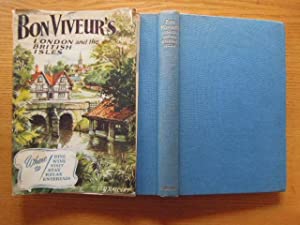
Egon Ronay, along with Raymond Postgate, has become a byword for good food guides in the UK. But did you know that the ‘ Bon Viveur ‘ double act of Phyllis ‘Fanny ‘ Cradock and wine expert husband ‘Johnnie ‘ reported on it with great enthusiasm in their 1955 guide to hotels and restaurants in London and the provinces ?
Here is their report:
‘London’s most food-perfect small restaurant. Two restaurants, in fact, for the price of one. By day this chic rendezvous draws women of international elegance who provide the restaurant with an ever-changing mannequin display as they nibble the now famous brioche toast and drink impeccable coffee in tall glasses. It is, in short, a baby Sacher’s ( from Vienna) , where Viennese and Swiss gateaux compete in popularity with Hungarian Dobos. By night the counters of patisseries and cocktail snacks disappear. Padded banquettes, candlelight and pink tablecloths form background to tranquil dining and the light flickers on climbing plants, the striped, canopied ceiling, the fruit baskets and the impeccable cheese board on the cold table. The Marquee is always filled with couples—romance thrives upon good food and wine. We single out for special commendation the luncheon-time Omelette du Chef with fresh crème and mushrooms (6s 6d) and the Poulet au Riz Sauce Supreme ( 6s. 6d ) plus an excellent table d’hote luncheon for 7s 6d.
In the afternoon the Savoury Gateaux, 2s per slice, is a superlative bonne bouche ; foie gras mousse , mousse of smoked salmon , egg puree and anchovy paste are layered with brioche bread and subtly garnished into gateaux form,
By night Bisque d’Homard (4s 6d) and a magnificent 9s 6d Bouillabaisse lead on to Quenelles de Brochet-the real Quenelles for 7s 6d., a delicate 7s 6d Sole Florentine, Rognons Bange (7s 6d.) with cream and wine, and occasionally a gateaux which is without equal in this town, rather ineptly christened Walnut Souffle Gateaux. But do not bother about its name. Taste it. It is made without any flour at all and is rich in cream and rum. The commendable wines include a light, clean steinwein to marry with fish dishes ( 27s 6d) , ’47 Haut Brion ( Chateau-bottled) 37s. 6d., ’45 Leoville Barton 29s. 6d, and ’49 Vosne Romanee 21s. Amusez-vous bien mes enfants!
Hours of opening:
Coffee from 10 a.m.
Luncheon: 12 noon to 3p.m.
Tea: 3.30 to 6 p.m.
Dinner and Supper: 6.30 p.m. to midnight
Closed on Sundays.
According to Wikipedia, Ronay was born in Bratislava in 1915 (which makes him a Czech rather than a Hungarian), Ronay’s father and grandfather were both restaurateurs, but ( according to his autobiography) he eschewed the family business and instead read Law in Budapest, graduating with an LL.D. After this he appears to have entered the family business which suffered during the Soviet occupation. In 1946 he left behind his wife and children to begin a new life in London, where his father’s contacts arranged for him to manage the Society restaurant in Jermyn Street and subsequently 96, Piccadilly, where it was his job to ‘dress the room ‘ so that customers entering the dining room could spot the celebrities of the day or at least see pretty girls at the tables.
In 1952 Ronay borrowed £4,000 to take over the Marquee, a former 39 seat tea room near Harrods, where he established French cuisine under the aegis of Jean Bardes from the French Riviera. One of Ronay’s obituarists, the literary scholar and food writer Dr Paul Levy, was sceptical about some of Ronay’s account of his life in Hungary, including his date of birth and wartime record, accusing this ‘self publicist’ of being economical with the truth to suit his himself, and writing out his wife from his memoirs. He is also suspicious of Fanny and Johnnie’s impartiality regarding their entry on The Marquee. To Levy, Fanny was a ‘liar and double bigamist who knew even less about food than Ronay, and had hard-core suburban taste ‘. She got Ronay to join her ‘ Brains Trust ‘ flying circus tour around the UK in which she and Johnnie gave cookery demonstrations, and when Fanny defected to the Daily Mail from the Telegraph Ronay took over her slot there.
Indeed there is something a bit obsequious and OTT about the Bon Viveur entry on Ronay’s restaurant. Nevertheless, at a time when, following the culinary deprivation of the War, Elizabeth David was beginning to bring the delights of French cuisine to the domestic English table, a restaurant like The Marquee, which seems to have served delicious if not inexpensive food, must have been welcome in post-war London.
R. M. Healey
